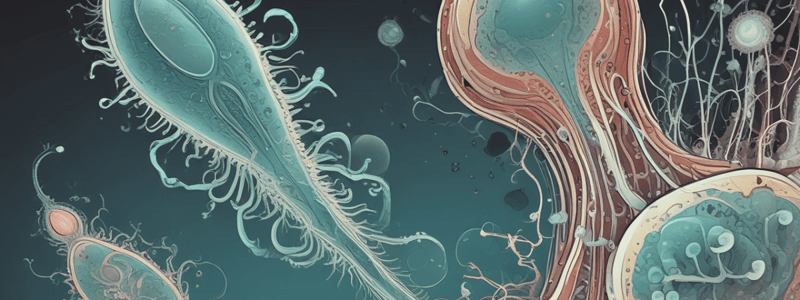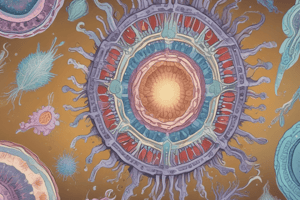Podcast
Questions and Answers
Giardia lamblia is a type of blood and tissue sporozoa
Giardia lamblia is a type of blood and tissue sporozoa
False
Giardia lamblia is found in lakes, streams, and other water sources worldwide
Giardia lamblia is found in lakes, streams, and other water sources worldwide
True
Giardia lamblia has 4 flagella
Giardia lamblia has 4 flagella
False
Giardia lamblia is transmitted through the fecal-oral route
Giardia lamblia is transmitted through the fecal-oral route
Signup and view all the answers
Giardia lamblia has a single nucleus
Giardia lamblia has a single nucleus
Signup and view all the answers
Giardia lamblia can be detected in a single stool specimen.
Giardia lamblia can be detected in a single stool specimen.
Signup and view all the answers
Trichomonas vaginalis has a cyst form.
Trichomonas vaginalis has a cyst form.
Signup and view all the answers
Trichomonas vaginalis is usually asymptomatic in females.
Trichomonas vaginalis is usually asymptomatic in females.
Signup and view all the answers
Kohn staining is used to detect cysts in formed stool.
Kohn staining is used to detect cysts in formed stool.
Signup and view all the answers
Trichomonas vaginalis is transmitted by contaminated food and water.
Trichomonas vaginalis is transmitted by contaminated food and water.
Signup and view all the answers
Giardia lamblia has 2 nucleus.
Giardia lamblia has 2 nucleus.
Signup and view all the answers
Infection of Giardia lamblia occurs through skin contact.
Infection of Giardia lamblia occurs through skin contact.
Signup and view all the answers
Giardia lamblia can multiply by longitudinal binary fission in the colon.
Giardia lamblia can multiply by longitudinal binary fission in the colon.
Signup and view all the answers
The cyst is the infectious stage of Giardia lamblia.
The cyst is the infectious stage of Giardia lamblia.
Signup and view all the answers
Giardia lamblia is typically found in the large intestine.
Giardia lamblia is typically found in the large intestine.
Signup and view all the answers
Giardia lamblia causes inflammation in the kidney.
Giardia lamblia causes inflammation in the kidney.
Signup and view all the answers
Giardia lamblia can be diagnosed through serology tests.
Giardia lamblia can be diagnosed through serology tests.
Signup and view all the answers
Giardia lamblia attaches to the epithelial surface of the mucosa layer.
Giardia lamblia attaches to the epithelial surface of the mucosa layer.
Signup and view all the answers
All patients infected with Giardia lamblia show symptoms.
All patients infected with Giardia lamblia show symptoms.
Signup and view all the answers
Giardia lamblia infection can cause malabsorption of fat.
Giardia lamblia infection can cause malabsorption of fat.
Signup and view all the answers
Dientamoeba fragilis is a type of intestinal and atrial flagellate.
Dientamoeba fragilis is a type of intestinal and atrial flagellate.
Signup and view all the answers
Balantidium coli is the largest protozoan parasite of humans.
Balantidium coli is the largest protozoan parasite of humans.
Signup and view all the answers
The trophozoite stage of Balantidium coli has a single nucleus.
The trophozoite stage of Balantidium coli has a single nucleus.
Signup and view all the answers
Balantidium coli can invade the liver and other extraintestinal sites.
Balantidium coli can invade the liver and other extraintestinal sites.
Signup and view all the answers
Metronidazole is not effective in treating Balantidium coli infections.
Metronidazole is not effective in treating Balantidium coli infections.
Signup and view all the answers
Study Notes
Intestinal and Atrial Flagellates and Ciliates
Giardia lamblia
- Distribution: Worldwide, particularly in England, Russia, and Eastern Europe
- Found in lakes, streams, and other water sources
- Kingdom: Protista, Subkingdom: Protozoa, Phylum: Sarcomastigophora, Subphylum: Mastigophora
- Class: Zommastigophora, Order: Diplomonadida, Family: Hexamitidae, Genus: Giardia, Species: lamblia
- Transmission: Fecal-oral route, ingestion of food and water contaminated with animal or human feces
- Characteristics: Pear-shaped, 8 flagella, bilateral symmetry, 2 nucleus, fine granular cytoplasm
- Life cycle: Ingestion of cysts, excystation in small intestine, multiplication by longitudinal binary fission, encystation in colon
- Pathogenesis: Causes giardiasis, inhabits glandular crypts of mucosa layer in duodenum and jejunum, attaches to epithelial surface, disrupts intestinal function, causes malabsorption, weight loss, and steatorrhea
- Laboratory diagnosis: Stool examination, duodenal fluid examination, serum examination
- Treatment: Quinacrine or metronidazole, furazolidone for children
- Prevention: Avoiding contaminated food and water, proper disposal of feces, good personal hygiene, proper storage of food and water
Trichomonas vaginalis
- Genital flagellates, found in vagina and urethra
- Distribution: Worldwide
- Transmission: Sexual contact, contaminated towels, infected examination equipment, infants during birth
- Characteristics: Pear-shaped, round anterior, pointy posterior, 4 anterior flagella, undulating membrane, ovoid nucleus
- Life cycle: No cyst form, exists only as trophozoite, multiplies by longitudinal binary fission
- Pathogenesis: Causes trichomoniasis, infects urethra in males, causes vaginitis in females
- Laboratory diagnosis: Microscopic examination of vaginal or urethral discharge
- Treatment: Metronidazole
Dientamoeba fragilis
- Characteristics: Microscopic examination, detection of motile trophozoite in a wet preparation
- Staining: Trichrome staining
Balantidium coli
- Phylum: Ciliophora, Family: Balantididae
- Distribution: Worldwide, natural host: pigs, accidental host: man
- Characteristics: Largest protozoan, site: large intestine, reservoirs: monkeys, pigs, rats
- Life cycle: Trophozoite and cyst stages, active motile trophozoite with cilia, spherical cyst with thick double-layered wall
- Pathogenesis: Causes mucosal ulcers and submucosal abscesses, does not invade liver or extraintestinal sites
- Laboratory diagnosis: Stool examination, biopsy, cultures
- Treatment: Tetracycline, metronidazole, nitroimidazole
Studying That Suits You
Use AI to generate personalized quizzes and flashcards to suit your learning preferences.
Related Documents
Description
Identify and learn about different types of protozoa and sporozoa that infect humans, including Iodamoeba butschlii, Dientamoeba fragilis, and more. Test your knowledge of parasitology and microbiology!




